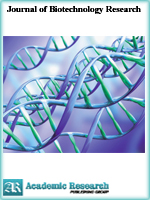Journal of Biotechnology Research
Online ISSN: 2413-3256
Print ISSN: 2413-8878
Print ISSN: 2413-8878
Quarterly Published (4 Issues Per Year)

Archives
Volume 5 Number 12 December 2019
Removal of Water Emulsified in Mineral Oil – An Alternative Approach
Authors: Dr. Frank Mayer
Pages: 154-156
DOI: doi.org/10.32861/jbr.512.154.155
Abstract
Mineral oil in metal containments with access of outside air may become contaminated with humidity present in the air because water starts to condense on cold metallic surfaces. An approach for the removal of this water moiety would be to remove it with polysaccharides that have the property of swelling up by water uptake. The polysaccharides can be fixed to carriers such as expanded clay particles. When oil containing water comes in contact with the polysaccharide coat, the water is taken up; the coated carriers containing water can be removed. A device is described that may allow application of this principle.
Physiological Responses and Nutritional Composition of Two Tomato (Lycopersicum esculentum) Cultivars-Roma-VF and IFE-1
Authors: Emmanuel A. Oguntola ; Foluso Ologundudu ; Idris Saheeb Oladele
Pages: 145-153
DOI: doi.org/10.32861/jbr.512.145.153
Abstract
This work investigates the growth and physiological responses of locally grown tomato cultivars with a known hybrid (Roma-VF cultivars). Seeds of two tomato cultivars: Roma VF (Lycopersicum esculentum Mill.Cv) was collected from National Horticulture Research Institute (NIHORT), Ibadan while the Local tomato: Ife-1 (Lycopersicum esculentum Mill. Cv) obtained from the market woman in the central market, Obafemi Awolowo University, Ile- Ife. The seed of the plant were planted in perforated plastic containers containing soil collected at the base of hill 1(latitude 7’3’9.40 and longitude 4’3’24.52) in Obafemi Awolowo University Ile-Ife, Osun State. The containers placed where they can have access to direct sunlight. The growth parameters of the plants were determined which include the leaf length, width and the shoot size was observed. The weight and growth rate of the shoot were determined. The fruits obtained from all the cultivar were exposed to proximate analysis. It was observed that the shoot of the two cultivars increased in the course of the experiment but at the end the shoot of Roma () was longer than that of local cultivar. More number of leaves was present in Roma compare to local one. Roma has higher moisture content (5.9% M.C)) than the local cultivar (4.7% M.C). Average number of fruits in Roma was (15) which is higher than that of local one (10). From all the parameters observed in this work it was observed that Roma cultivar which is a hybrid do far better in all indication than the local tomato cultivar. This may be as a result of Roma hybrid characteristics such as resistances to disease and unfavorable environmental factors. Equally the improved nutritional value of the Roma tomato and lot of genetically modified features are key to this cultivar (Roma) advancement.
Proximate Analysis of Locally Prepared Vended Dishes in Owerri Municipality of Imo State
Authors: Adaramaja Mercy F.
Pages: 140-144
DOI: doi.org/10.32861/jbr.512.140.144
Abstract
This study is aimed at evaluating the food vendor’s practices, proximate analysis of locally prepared vended dishes in Owerri Municipality of Imo state. Five zones (A, B, C.D and E) were considered and the food assessed were cooked spaghetti, beans, rice and stew. The proximate analysis of the food samples revealed that the mean moisture content ranged from 59.91% in cooked spaghetti to 89.0% in stew. Protein content varied from 2.23% in stew to 13.45% in cooked beans, while Fat varied from 0.13% in cooked rice to 8.02% in stew; Ash ranged from 0.22% in cooked beans to 0.81% in stew; Carbohydrate ranged from 17.73% in cooked beans to 36.33% in cooked spaghetti; the Nitrogen Free Extract (NFE) present only in stew ranged from 0.43% in Zone E to 3.28% in Zone A. It was concluded that street foods provide a source of affordable nutrients to the majority of the people especially the low-income group in the developing countries, however, all the proximate components were within the normal range in the zones.
Functional Properties of Physalis Pubescens Linnaeus: A Literature Review
Authors: Tailise Beatriz Roll Zimmer ; Deborah Murowaniecki Otero ; Rui Carlos Zambiazi
Pages: 128-139
DOI: doi.org/10.32861/jbr.512.128.139
Abstract
Physalis pubescens L. has exotic fruit, native to the Americas, with potential to be widely used for consumption. This plant has yellow fruits accompanied by chalices. The aerial parts are used in traditional medicine due to its preventive and curative effect. Its fruits are aromatic and mildly acidic, besides containing compounds that contribute to the functional capacity of the fruit. Due to the health benefits, the use of this plant has generated a great commercial interest. Purpose of this review was to compile information on the functional properties of Physalis pubescens, as well as to explore information on some of the major species of Physalis.



